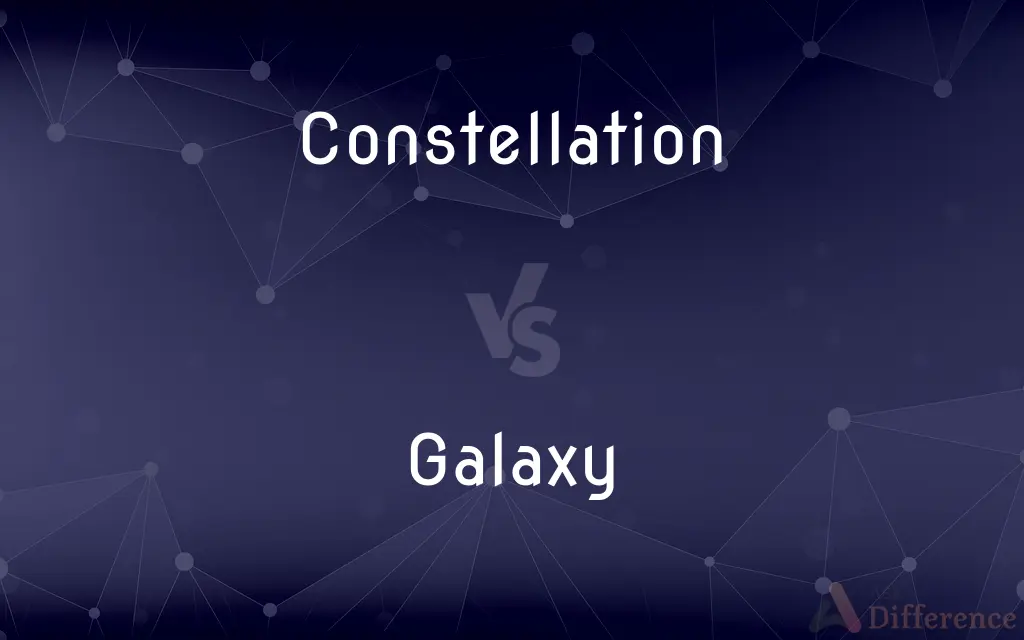Constellation vs. Galaxy — What's the Difference?
Edited by Tayyaba Rehman — By Maham Liaqat — Updated on March 6, 2024
A constellation is a group of stars visibly forming a pattern in the night sky from Earth, while a galaxy is a massive, gravitationally bound system of stars, gas, dust, and dark matter.

Difference Between Constellation and Galaxy
Table of Contents
ADVERTISEMENT
Key Differences
Constellations are patterns of stars as seen from Earth's perspective, historically used for navigation, storytelling, and as part of astronomical studies. They are not physically connected; the stars in a constellation can be vast distances apart but appear grouped from our viewpoint. On the other hand, a galaxy is a massive, cohesive structure of stars, interstellar gas, dust, and dark matter, bound together by gravity. Our galaxy, the Milky Way, contains billions of stars, including our sun, and is just one of the countless galaxies in the universe.
While constellations are apparent groupings of stars based on line of sight, galaxies are actual astronomical units, with stars within them bound by gravitational forces. Constellations have been named and cataloged by various cultures throughout history, and their shapes and mythologies differ across cultures. In contrast, galaxies are studied as physical entities in the universe, classified into shapes such as spiral, elliptical, and irregular, based on their appearance.
Constellations serve as a practical means to navigate and identify specific stars or celestial events within the night sky. They act as markers that help astronomers, sailors, and hobbyists to orient themselves and track celestial occurrences. Galaxies, however, are the subject of scientific research aimed at understanding the universe's formation, structure, and the distribution of galaxies within it.
The study of constellations falls under the broader field of astronomy, focusing on the patterns and history of stars as seen from Earth. Galaxy study, or galactic astronomy, involves examining the formation, evolution, and components of galaxies, as well as their distribution and interactions in the cosmos. This distinction highlights how constellations relate more to the observational aspect of astronomy, while galaxies pertain to the physical and cosmological aspects.
Constellations and galaxies represent different scales and concepts in astronomy: constellations are patterns of stars from Earth's perspective, used for navigation and storytelling, while galaxies are vast, gravitationally bound systems that are fundamental to our understanding of the universe's structure and evolution.
ADVERTISEMENT
Comparison Chart
Definition
A pattern of stars visible from Earth, not physically connected
A massive, gravitationally bound system of stars, gas, dust, and dark matter
Scale
Appears as a group of stars in the night sky
Contains billions to trillions of stars, along with other components
Purpose/Use
Navigation, storytelling, astronomical orientation
Study of the universe's structure, formation, evolution
Physical Connection
No physical connection between stars
Stars and other components bound by gravity
Cultural Significance
Named and mythologized by different cultures
Studied scientifically, less culturally specific
Types/Classification
88 recognized constellations, no physical types
Classified as spiral, elliptical, irregular based on shape
Study Field
Observational astronomy
Galactic astronomy, cosmology
Compare with Definitions
Constellation
A group of stars forming a recognizable pattern that is traditionally named.
Orion is one of the most well-known constellations, easily identifiable by its belt.
Galaxy
A vast collection of stars, dust, gas, and dark matter bound by gravitational forces.
The Milky Way Galaxy is our home galaxy, containing our solar system.
Constellation
Serves as a tool for astronomers to segment the sky.
Astronomers locate celestial objects by referring to their positions within constellations.
Galaxy
Can interact and merge with other galaxies in cosmic events.
The Milky Way and Andromeda galaxies are expected to collide in about 4 billion years.
Constellation
Used for celestial navigation and storytelling across cultures.
Sailors have used the North Star in the constellation Ursa Minor for navigation.
Galaxy
Comes in various shapes, including spiral, elliptical, and irregular.
The Andromeda Galaxy is a spiral galaxy, similar to the Milky Way.
Constellation
88 constellations are officially recognized by astronomers.
The constellation Leo represents a lion and is visible in the spring sky.
Galaxy
Subject of study in cosmology and galactic astronomy.
Researchers study galaxy formation to understand the universe's evolution.
Constellation
Consists of stars that appear close from Earth but are far apart in space.
The stars in the Big Dipper constellation are hundreds of light-years apart.
Galaxy
Contains billions to trillions of stars, along with planetary systems.
The Milky Way has over 200 billion stars.
Constellation
A constellation is an area on the celestial sphere in which a group of visible stars forms a perceived outline or pattern, typically representing an animal, mythological person or creature, or an inanimate object.The origins of the earliest constellations likely go back to prehistory. People used them to relate stories of their beliefs, experiences, creation, or mythology.
Galaxy
A galaxy is a gravitationally bound system of stars, stellar remnants, interstellar gas, dust, and dark matter. The word galaxy is derived from the Greek galaxias (γαλαξίας), literally "milky", a reference to the Milky Way.
Constellation
A group of stars forming a recognizable pattern that is traditionally named after its apparent form or identified with a mythological figure.
Galaxy
A system of millions or billions of stars, together with gas and dust, held together by gravitational attraction.
Constellation
A grouping of stars on the celestial sphere perceived as a figure or design, especially one of the 88 recognized groups named after characters from classical Greek and Roman mythology as well as various common animals and objects.
Galaxy
Any of numerous large-scale aggregates of stars, gas, and dust that constitute the universe, containing an average of 100 billion (1011) solar masses and ranging in diameter from 1,500 to 300,000 light-years.
Constellation
An area of the celestial sphere occupied by one of the 88 recognized constellations.
Galaxy
Often Galaxy The Milky Way.
Constellation
The configuration of planets at the time of one's birth, regarded by astrologers as determining one's character or fate.
Galaxy
An assembly of brilliant, glamorous, or distinguished persons or things
A galaxy of theatrical performers.
Constellation
A gathering or assemblage, especially of prominent persons or things
The symposium was attended by a constellation of artists and writers.
Galaxy
The Milky Way; the apparent band of concentrated stars which appears in the night sky over earth.
Constellation
A set or configuration, as of related items, properties, ideas, or individuals
A constellation of demands ranging from better food to improved health care.
A constellation of feelings about the divorce.
Galaxy
(galaxy) Any of the collections of many millions or billions of stars, galactic dust, black holes, etc. existing as independent and coherent systems, of which there are billions in the known universe.
Constellation
(astronomy) An asterism, an arbitrary formation of stars perceived as a figure or pattern, or a division of the sky including it, especially one officially recognised by astronomers.
Galaxy
(figuratively) An assemblage of things or people seen as luminous or brilliant.
Constellation
Any of the 88 regions of the sky officially recognized by the IAU, including all stars and celestial bodies in the region.
Galaxy
Any print or pattern reminiscent of a galaxy, generally consisting of blending, semiopaque patches of vibrant color on a dark background.
Constellation
An image associated with a group of stars.
Galaxy
To furnish with galaxies.
Constellation
(astrology) The configuration of planets at a given time (notably of birth), as used for determining a horoscope.
Galaxy
(archaic) To gather together into a luminous whole.
Constellation
(figuratively) A wide, seemingly unlimited assortment.
A constellation of possibilities.
Galaxy
The Milky Way, that luminous tract, or belt, which is seen at night stretching across the heavens, and which is composed of innumerable stars, so distant and blended as to be distinguishable only with the telescope.
Constellation
(spaceflight) A fleet of satellites of the same purpose such as the set of GPS satellites, or Iridium satcom fleet.
Galaxy
A very large collection of stars comparable in size to the Milky Way system, held together by gravitational force and separated from other such star systems by large distances of mostly empty space. Galaxies vary widely in shape and size, the most common nearby galaxies being over 70,000 light years in diameter and separated from each other by even larger distances. The number of stars in one galaxy varies, and may extend into the hundreds of billions.
Constellation
A configuration or grouping.
Galaxy
A splendid or impressive assemblage of persons or things; as, a galaxy of movie stars.
Constellation
A network of connections that exists between people who are in polyamorous relationships, for example between one person, their partner, and that person's partner.
Galaxy
A splendid assemblage (especially of famous people)
Constellation
A cluster or group of fixed stars, or division of the heavens, designated in most cases by the name of some animal, or of some mythologial personage, within whose imaginary outline, as traced upon the heavens, the group is included.
The constellations seem to have been almost purposely named and delineated to cause as much confusion and inconvenience as possible.
Galaxy
Tufted evergreen perennial herb having spikes of tiny white flowers and glossy green round to heart-shaped leaves that become coppery to maroon or purplish in fall
Constellation
An assemblage of splendors or excellences.
The constellations of genius had already begun to show itself . . . which was to shed a glory over the meridian and close of Philip's reign.
Galaxy
(astronomy) a collection of star systems; any of the billions of systems each having many stars and nebulae and dust;
`extragalactic nebula' is a former name for `galaxy'
Constellation
Fortune; fate; destiny.
It is constellation, which causeth all that a man doeth.
Constellation
An arrangement of parts or elements;
The outcome depends on the configuration of influences at the time
Constellation
A configuration of stars as seen from the earth
Common Curiosities
What is the difference between a constellation and a galaxy?
A constellation is a pattern of stars visible from Earth, while a galaxy is a gravitationally bound system of stars, gas, and dark matter.
What is the closest galaxy to Earth?
The closest major galaxy to Earth is the Andromeda Galaxy.
Can a galaxy be part of a constellation?
Yes, galaxies can appear within the boundaries of constellations as seen from Earth, but they are distinct, much larger celestial entities.
How many constellations are there?
There are 88 officially recognized constellations.
Why are constellations important?
Constellations have been used for navigation, to mark seasons, and for cultural storytelling throughout human history.
Are all stars in a constellation close to each other?
No, stars in a constellation may appear close from Earth's perspective but can be very far apart in space.
What type of galaxy is the Milky Way?
The Milky Way is a barred spiral galaxy.
Is the Sun in a constellation?
From Earth's perspective, the Sun does not belong to any constellation, but it is located in the Milky Way Galaxy.
What role do dark matter and dark energy play in galaxies?
Dark matter provides the gravitational glue that holds galaxies together, while dark energy is thought to drive the universe's accelerated expansion, affecting galaxy distribution.
Can constellations change over time?
Yes, due to the movement of stars, constellations can slowly change shape over thousands or millions of years.
How are galaxies formed?
Galaxies form from the gravitational collapse of gas and dust in the early universe, evolving through processes like star formation and mergers with other galaxies.
Do constellations serve a scientific purpose today?
Yes, constellations help astronomers organize the night sky for observational purposes, making it easier to locate and communicate about celestial objects.
How can we see galaxies?
Many galaxies can be seen with telescopes as faint, cloud-like structures beyond our Milky Way, especially from dark locations away from city lights.
How do astronomers classify galaxies?
Galaxies are classified by their shape as spiral, elliptical, or irregular.
Share Your Discovery

Previous Comparison
Modell vs. Model
Next Comparison
Inadvisable vs. UnadvisableAuthor Spotlight
Written by
Maham LiaqatEdited by
Tayyaba RehmanTayyaba Rehman is a distinguished writer, currently serving as a primary contributor to askdifference.com. As a researcher in semantics and etymology, Tayyaba's passion for the complexity of languages and their distinctions has found a perfect home on the platform. Tayyaba delves into the intricacies of language, distinguishing between commonly confused words and phrases, thereby providing clarity for readers worldwide.














































